Plot summary
Tallis summons Detective Inspector Robert Colbeck to his office and orders him to lead the investigation. It is quickly established that there is an "unresolved tension" between Tallis and Colbeck which is an underlying theme of the whole series, although the two have great professional respect for each other. Colbeck and Detective Sergeant Victor Leeming travel to Leighton Buzzard where they meet Inspector Rory McTurk of the railway police. McTurk strongly resents their involvement but Colbeck and Leeming soon establish that members of the railway police were guilty of deserting their posts on the train in order to play cards, thus making it much easier for the gang to carry out the robbery. Meanwhile, train driver Caleb Andrews is not expected to survive and his daughter Madeleine arrives in Leighton Buzzard to care for him.
Colbeck is convinced that the gang had inside information and were certainly in possession of duplicated safe keys. He and Leeming begin enquiries at the organisations involved with the shipment: the L&NWR, the Post Office, the Royal Mint, the fictitious Spurling's Bank in Birmingham and the Chubb factory in Wolverhampton. As a result, they become aware of Daniel Slender, who duplicated the safe keys at Chubb; William Ings of the Post Office, who was involved in the mail train's scheduling; and Albert Woodhead of the Royal Mint, who unwittingly advised Ings of the gold consignment. The L&NWR and the Birmingham bank are absolved of involvement in the crime.
Ings is the first of the suspects to be pursued and Colbeck discovers that he is hiding in the notorious Devil's Acre. To find Ings, Colbeck seeks help from Brendan Mulryne, a former colleague who is now a resident there. Mulryne establishes a connection between Ings and the prostitute Polly Roach but, though he finds Roach, he is too late to prevent the murder of Ings. In due course, Slender meets a similar fate. It is clear to Colbeck that the gang are eliminating loose ends and weak links to remain undetected. Colbeck is concerned about the unnecessary destruction of the steam engine after the robbery and believes he is looking for someone with influence who hates the railways.
Although Tallis dismisses Colbeck's theory, it is valid as gang leader Sir Humphrey Gilzean has an obsessive hatred of railways. He blames them for the accidental death of his wife. The gang strikes again at the Kilsby Tunnel, placing gunpowder at one end in a bid to destroy both the tunnel and a train carrying glass sheets for use in the Crystal Palace. The explosion is detonated too soon to destroy the train and causes only superficial damage to the tunnel. Colbeck makes the connection and realises, despite more opposition from Tallis, that an attempt will be made to destroy the locomotives on display at the Great Exhibition.
Colbeck is right about the Crystal Palace and, aided by Leeming and Mulryne, is able to arrest Jukes and the Seymours one night when they try to destroy the Lord of the Isles . The gangsters refuse to give information about their leaders. Gilzean and Sholto have added to their haul by blackmailing the senders of complicit letters which were in the stolen mailbags. They are fearful of imminent arrest and Gilzean instructs Sholto to find someone whom Colbeck cares about to distract him from the investigation. Caleb Andrews is no longer a critical case and has been taken home where Madeleine is looking after him. She has met Colbeck in the course of the investigation and there is a mutual attraction between them which develops as the novel progresses. Sholto follows Colbeck and observes the affection he has for Madeleine during a visit to the Andrews household. As a result, Gilzean and Sholto kidnap Madeleine and send a demand to the Met for the release of Jukes and the Seymours.
Working on what little is known about the three prisoners, Colbeck and Leeming discover their common military background and make the link between them and two of their former officers who both left the Army on the same day. These are Gilzean and Sholto. Colbeck establishes that Gilzean has a pathological hatred of railways and even Tallis agrees that the case has been solved, so the investigation is now a manhunt but with Madeleine's life at stake. Fortunately for Madeleine, Gilzean is protective of her and will not allow Sholto to molest her. Tallis leads a raid on Gilzean's Berkshire residence but he bungles it and the criminals escape, still holding Madeleine as a hostage.
Colbeck finds documents in Gilzean's house which convince him they are taking Madeleine to Bristol to board ship and flee the country. The criminals are travelling by road and so Colbeck and Leeming go to Bristol via the Great Western Railway (GWR). They arrive first and intercept the two criminals on board their ship in harbour. Madeleine, unharmed, is freed and reunited with her father. The bond between Colbeck and Madeleine is permanent and, when Colbeck receives two complimentary tickets from the grateful Prince Albert for the opening of the Great Exhibition, he invites Madeleine to join him.
Historical references
The Detective Department of the Metropolitan Police Force (the Met) was founded in 1842 and so was only nine years old in 1851, when the story is set. Richard Mayne, who was the joint first commissioner of the Met, is depicted in meetings with Tallis, Colbeck and Leeming. His co-commissioner, Charles Rowan, had retired the year before. Mayne was in charge of policing at The Great Exhibition which opened on 1 May and was an outstanding success, thanks in no small part to effective policing. Mayne is the only real person who plays an active part in the novel.
The novel mentions Prince Albert as the exhibition organiser and Joseph Paxton as its main designer. Gilzean's hatred of Paxton was because of Paxton being a director of the Midland Railway, whose chairman John Ellis is an enemy of Gilzean. The Lord of the Isles was a noted locomotive which was displayed at the Great Exhibition before it entered service on the Great Western Railway (GWR). Colbeck mentions the 6-2-0 Liverpool, the Puffing Billy and the 4-2-2 Iron Duke in the context of the exhibition. In the second book, when Madeleine begins to seriously pursue her hobby of locomotive artworks, the Lord of the Isles is her first subject.
Caleb Andrews drives for the L&NWR but his train was travelling on the route built by the London and Birmingham Railway (L&BR) and opened in 1838. The L&BR was amalgamated into the L&NWR in 1846, having been operational since 1833. Robert Stephenson was the L&BR chief engineer. The line from Euston to Birmingham included the Linslade and Kilsby tunnels which both feature prominently in the book. Marston describes the problems Stephenson faced at Kilsby, where quicksand was unexpectedly encountered. The Crystal Palace's construction materials, its cast iron framework and sheets of glass, were manufactured in Birmingham and Smethwick, so they were transported by rail through the Kilsby tunnel to London.
Train robbery was a new phenomenon in the 1850s. There were two in reality before 1851, both on the Bristol and Exeter Railway in 1849. Security was non-existent and the robbers in each case climbed out of their own carriage into the mail van and back. The first major incident was the Great Gold Robbery on the South Eastern Railway in May 1855. The first train robbery in America was by the Reno Gang in Indiana in 1866; there were more infamous robberies in later years by the James–Younger Gang and Butch Cassidy's Wild Bunch.
The Birmingham bank manager, Ernest Kitson, explains to Colbeck the purpose of the Bank Charter Act 1844 which was introduced by the late Robert Peel as prime minister. The Act is often called the "Peel Banking Act". It placed strict limits on the issue of banknotes by individual banks who were required to balance all banknotes in their possession with a requisite supply of gold coin or bullion. In the novel, it is because Spurling's fully complied with these rules that a gold consignment was being sent to them.
On his trip to Birmingham and Wolverhampton, Colbeck is disturbed by seeing the Black Country and afterwards tells Leeming that he now understands exactly what William Blake meant when he wrote about the "dark, satanic mills". Colbeck is nevertheless intrigued by industry, especially the railways, and in conversations he refers to Edward Bury, Thomas Russell Crampton and Daniel Gooch as engineers and locomotive designers he especially admires. Caleb Andrews speaks well of Alexander Allan, who claimed to be the designer of the Crewe type locomotive involved in the robbery. The engine was a 2-4-0 introduced by the L&NWR for freight in 1845. Allan was L&NWR works manager at Crewe Works from 1843 to 1853.

The Great Train Robbery was the robbery of £2.61 million from a Royal Mail train travelling from Glasgow to London on the West Coast Main Line in the early hours of 8 August 1963 at Bridego Railway Bridge, Ledburn, near Mentmore in Buckinghamshire, England.

The London and North Western Railway was a British railway company between 1846 and 1922. In the late 19th century, the LNWR was the largest joint stock company in the world.

The London and Birmingham Railway (L&BR) was a railway company in the United Kingdom, in operation from 1833 to 1846, when it became part of the London and North Western Railway (L&NWR).

Since the invention of locomotives in the early 19th century, trains have often been the target of robbery, in which the goal is to steal money or other valuables. Train robbery was especially common during the 19th century and is commonly associated with gangs of outlaws in the American Old West. It has continued into the 21st century, with criminals usually targeting freight trains carrying commercial cargo, or targeting passengers of public transportation for their valuables.

The Dalton Gang was a group of outlaws in the American Old West during 1890–1892. It was also known as The Dalton Brothers because four of its members were brothers. The gang specialized in bank and train robberies. During an attempted double bank robbery in Coffeyville, Kansas in 1892, two of the brothers and two other gang members were killed; Emmett Dalton survived, was captured, and later pleaded guilty to second-degree murder, although he later asserted that he never fired a shot during the robbery. He was paroled after serving 14 years in prison.

The Sign of the Four, also called The Sign of Four, is an 1890 detective novel, and it is the second novel featuring Sherlock Holmes by British writer Sir Arthur Conan Doyle. Doyle wrote four novels and 56 short stories featuring the fictional detective.
Keith Miles is a Welsh writer of historical fiction and mystery novels. He has also written children's books, radio and television dramas and stage plays. He is best known under the pseudonym Edward Marston, and has also written as Martin Inigo and Conrad Allen.

The Great Gold Robbery took place on the night of 15 May 1855, when a routine shipment of three boxes of gold bullion and coins was stolen from the guard's van of the service between London Bridge station and Folkestone while it was being shipped to Paris. The robbers comprised four men, two of whom—William Tester and James Burgess—were employees of the South Eastern Railway (SER), the company that ran the rail service. They were joined by the planners of the crime: Edward Agar, a career criminal, and William Pierce, a former employee of the SER who had been dismissed for being a gambler.
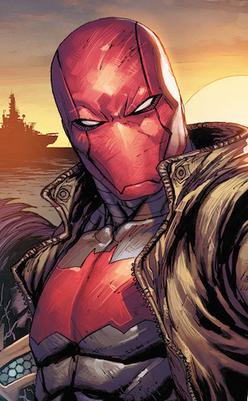
The Red Hood is an alias used by multiple characters appearing in American comic books published by DC Comics. The identity was first used in the 1951 story line "The Man Behind the Red Hood!", which provides the earliest origin story for the Joker. The storyline depicts an unnamed criminal wearing a red dome-shaped hood who, after a chance encounter with Batman, is disfigured by chemicals and becomes insane, giving birth to his future Joker persona.
Egan's Rats was an American organized crime gang that exercised considerable power in St. Louis, Missouri, from 1890 to 1924. Its 35 years of criminal activity included bootlegging, labor slugging, voter intimidation, armed robbery, and murder. Although predominantly Irish-American, Egan's Rats did include a few Italian-Americans and some Jewish immigrants, most notably Max "Big Maxie" Greenberg.
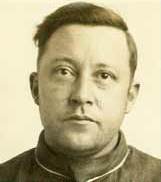
William P. "Dint" Colbeck was a St. Louis politician and organized crime figure involved in bootlegging and illegal gambling. He succeeded William Egan as head of the Egan's Rats bootlegging gang in the early 1920s.
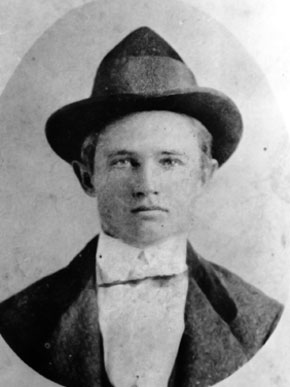
Reuben Houston Burrow was a train-robber and outlaw in the Southern and Southwestern United States. During the final years of the American frontier, he became one of the most infamous and hunted men in the Old West since Jesse James. From 1886 to 1890, he and his gang robbed express trains in Alabama, Arkansas, Louisiana, the Indian Territory and Texas while pursued by hundreds of lawmen throughout the southern half of the United States, including the Pinkerton National Detective Agency.
The Reno Gang, also known as the Reno Brothers Gang and The Jackson Thieves, were a group of criminals that operated in the Midwestern United States during and just after the American Civil War. Though short-lived, the gang carried out the first three peacetime train robberies in U.S. history. Most of the stolen money was never recovered.
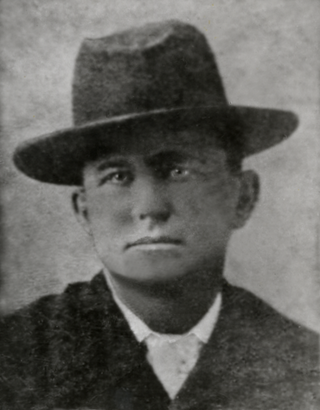
Mason Frakes Dalton, also known as William Marion "Bill" Dalton, was an outlaw in the American Old West. He was the co-leader of the Wild Bunch gang and with his brothers Gratton, Bob and Emmett Dalton was a member of the Dalton Gang.
The Newton Gang was an outlaw gang of the early 20th century, who engaged in train robbery and bank robbery. From 1919 through 1924 the gang robbed dozens of banks, claiming a total of seventy-five banks and six trains. According to Willis Newton, the brothers "took in more money than the Dalton Gang, Butch Cassidy's Wild Bunch and the James-Younger Gang combined." According to their own claims, they never killed anyone although it has been reported that "they did on occasion shoot, pistol-whip and beat their victims"

The Sign of Four is a 1932 British crime film directed by Graham Cutts and starring Arthur Wontner, Ian Hunter and Graham Soutten. The film is based on Arthur Conan Doyle's second Sherlock Holmes novel The Sign of the Four (1890). The film is also known as The Sign of Four: Sherlock Holmes' Greatest Case.
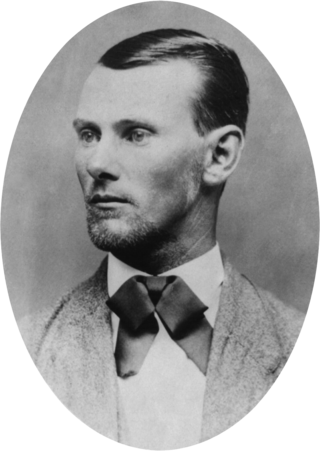
Jesse Woodson James was an American outlaw, bank and train robber, guerrilla and leader of the James–Younger Gang. Raised in the "Little Dixie" area of Missouri, James and his family maintained strong Southern sympathies. He and his brother Frank James joined pro-Confederate guerrillas known as "bushwhackers" operating in Missouri and Kansas during the American Civil War. As followers of William Quantrill and "Bloody Bill" Anderson, they were accused of committing atrocities against Union soldiers and civilian abolitionists, including the Centralia Massacre in 1864.
The Hogan Gang was a St. Louis–based criminal organization that sold illegal liquor during Prohibition in addition to committing labor slugging, voter intimidation, armed robbery, and murder. Although predominantly Irish-American, the Hogan Gang included several Italian and Jewish mobsters amongst their ranks; most notably, Max "Big Maxie" Greenberg. They fought a notoriously violent gang war with Egan's Rats in the early 1920s.
Ernest Malcolm Fewtrell was a Detective Chief Superintendent in the Buckinghamshire Constabulary and head of Buckinghamshire CID. He led the initial investigation into the Great Train Robbery in 1963.

The Railway Viaduct is the third title in the Railway Detective series of detective mystery novels written by Keith Miles under the pseudonym Edward Marston. Set in 1852, it is about a murder on a train which is investigated and ultimately solved by two Scotland Yard detectives, Inspector Robert Colbeck and Sergeant Victor Leeming. The title place is the Sankey Viaduct on the former Liverpool and Manchester Railway. The novel was published in 2006 by Allison & Busby of London. The graphic on the book cover is from T. T. Bury's 1831 depiction called Viaduct across the Sankey Valley in his Liverpool and Manchester Railway series of paintings. According to the publishers in a 2018 news release, the series has been optioned for television adaptation by Mammoth Screen.














